Auctions
Late Picasso Works Save an Otherwise Lackluster $46 Million Impressionist and Modern Art Sale at Christie’s London
Meanwhile, Barbara Hepworth and Frank Bowling headlined the auction house's lively Modern British art sale.
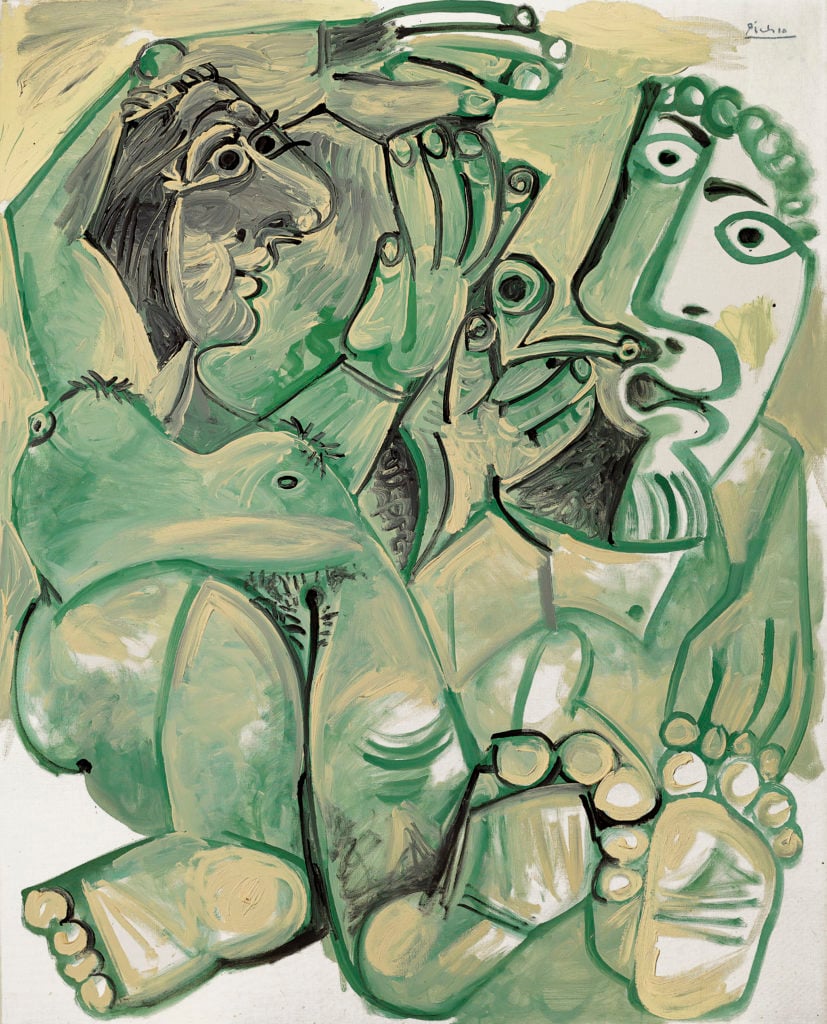
Meanwhile, Barbara Hepworth and Frank Bowling headlined the auction house's lively Modern British art sale.

Colin Gleadell

Christie’s kicked off London’s summer auction season with a short Impressionist and Modern evening sale. Two late paintings by Picasso and an early drawing by Egon Schiele were bright spots in an otherwise lackluster sale. The 31 lots brought in a total of £36.4 million ($45.6 million), under the estimate of £64.2 million to £89.8 million ($80.6 million-$112.8 million). The low estimate was down by 33 percent from last June and by 56 percent from the year before.
Keith Gill, the head of the sale, parried pre-auction questions about the decline and whether Brexit was a factor, saying that the house’s February sales were the second-highest ever in London and that clients had not been “going out of their way” to supply other locations, notably London’s nearest rival, Paris, which has been looking strong. “It gets more difficult season by season to find masterpieces for sale. We have also had one week less to pull business in than last year,” he said.
The auction house stressed that Brexit uncertainty did not dampen its sales of Modern British art on June 17-18, which saw sculptures by Barbara Hepworth and early paintings by Frank Bowling in high demand.
Only two works in the Impressionist and Modern Sale had upper estimates of more than £10 million ($12.6 million). A classic 1913 Léger tubist painting of a woman in an armchair carried an unpublished £25 million ($31.4 million) estimate, but seemed “less fully resolved” than usual, said art advisor Guy Jennings. It didn’t sell. A colorful Matisse portrait of a smart woman wearing an amber necklace looked a little too fresh. Sure enough, it had been poorly cared for when looted by the Nazis. Recently restituted to the heirs of the dealer Pierre Rosenberg, it had been relined and heavily retouched—all of which contributed to its failure to sell with a £5 million ($6.3 million) estimate.
But late Picasso came to the rescue. A large square painting from 1968 of a reclining couple was one of only two guaranteed lots in the sale. It sold to Christie’s Hong Kong representative Rebecca Wei for a mid-estimate £12.5 million ($15.6 million), while a 1967 self-portrait in the style of Velázquez, holding his brush, sold to the Nahmad family of art dealers for a mid-estimate £2.1 million ($2.6 million).
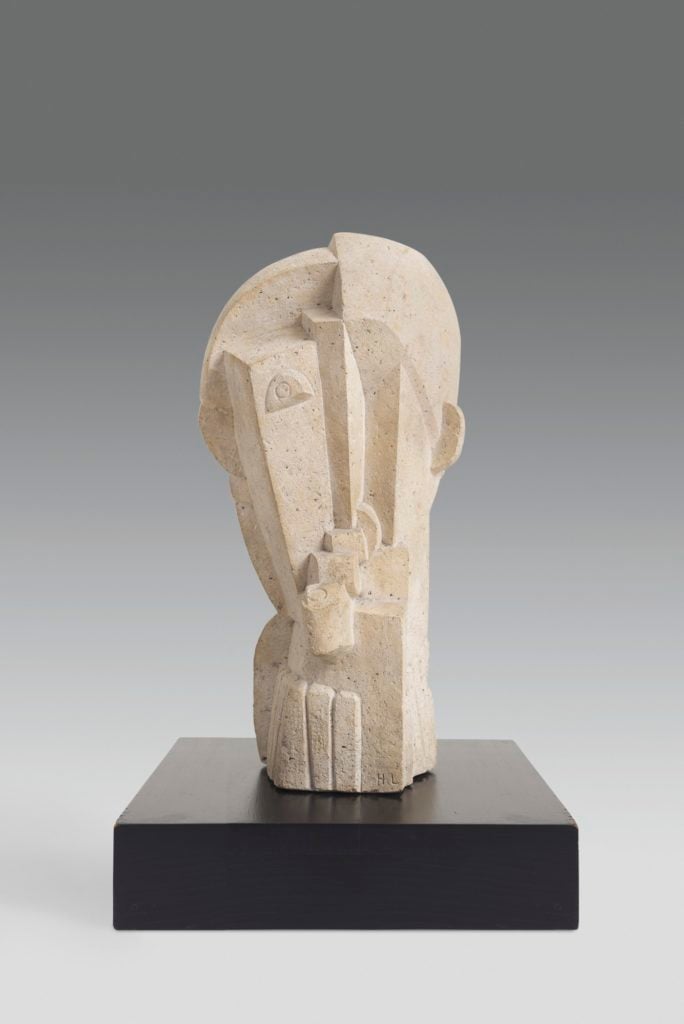
Henri Laurens, Homme a la pipe (1919). Image courtesy of Christie’s Images Ltd.
The opening stages of the sale had felt promising when a Schiele colored ink drawing of a reclining nude tripled its estimate to sell for £1.3 million ($1.6 million), and a cubistic stone head by Henri Laurens from 1919 saw New York adviser Abigail Asher bidding against London-based advisor Harry Smith of Gurr Johns. It ultimately sold to Smith above estimate for £1.4 million ($1.8 million).
Then came an 11-lot collection headlined “The Landscape of a Mind; a Private Collector’s Surrealist Vision.” Christie’s did not name the seller described in the catalogue by Surrealist specialist dealer Timothy Baum as “a scholar… of exquisite sensitivity.” Further investigation revealed that the works had been bought, mostly at auction, by the Bahamas-based British copper trader Robert Wylde, who died last year. Wylde is known for having taken Gagosian to court in 2011 when he discovered a painting he had bought by Mark Tansey had been promised by the owner (not Gagosian) to the Met. That painting was returned, and Wylde received compensation. Another Tansey he owned is to be sold in New York in November.
Most of the Wylde works this evening had been bought at auction within the past 20 years, and estimates were not set to make gains, though some did. An intense drawing by Salvador Dalí of a woman as a chest-of-drawers had fetched a drawing record for the artist of $478,400 when Wylde bought it in 2003. This time around it sold within estimate to Surrealist dealer Olivier Malingue for £971,250 ($1.2 million). Malingue was then the under bidder on a superb 1919 Dadaist collage by Hannah Höch, which sold to a phone bidder for a record £635,250.
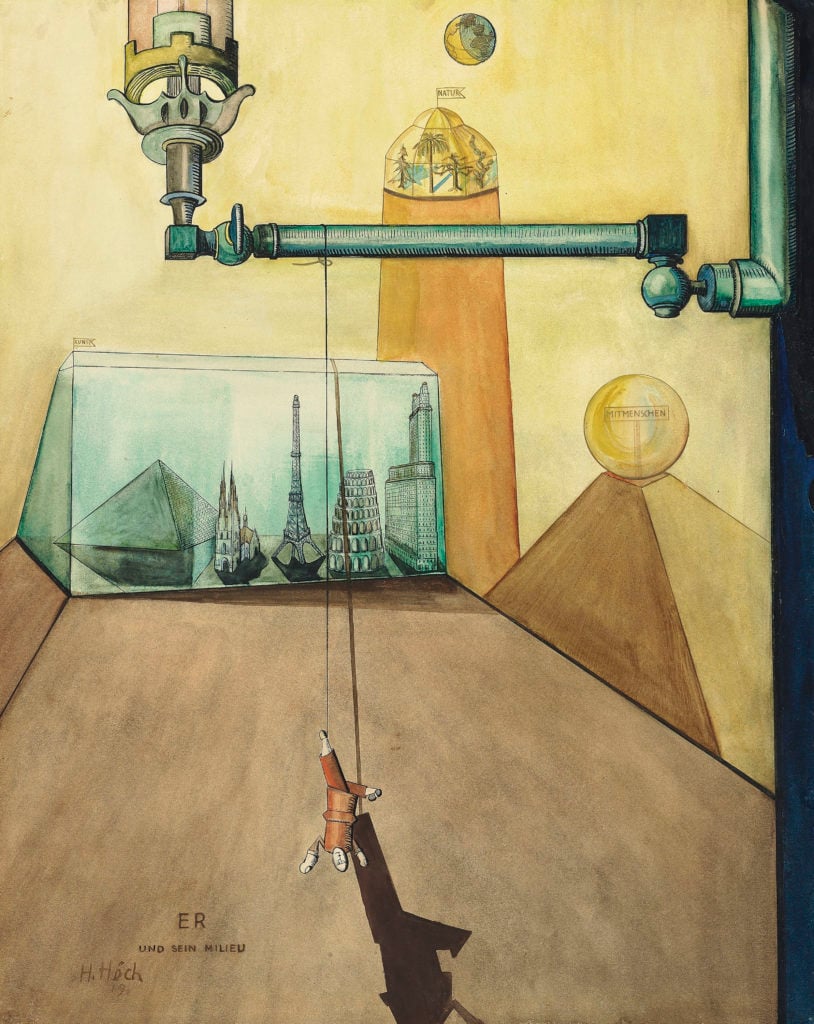
Hannah Höch, Er und sein Milieu (1919). Image courtesy of Christie’s Images Ltd.
Heading hopefully for a record was a surreal landscape, L’Extinction des Especes II (1938), by Yves Tanguy, but it fell just short selling for £3.1 million ($3.9 million).
A work by René Magritte, Le Palais Rideau, sold within estimate to Brussels-based dealer Paolo Vedovi, but the main Magritte, Le Parc du vautour, did not sell (estimate: £2.5-4 million). Nor did a Dalí-designed sofa in the shape of Mae West’s lips, which had an upper estimate of £600,000 ($750,000), slightly less than it was in 2016 when Wylde bought it for £725,000 ($910,000).
Timothy Baum, who knew the collection well, waited for his moment to pounce, seizing on a 1928 Giorgio de Chirico drawing, Oreste e Oilade, for a half-estimate £175,000 ($220,000). Wylde had bought it in 2012 for £770,000 ($967,000). And with the last lot from the collection, a poem and penknife by Andre Breton, Baum put in a bid on the low estimate to buy it for £250,000 ($314,000). Only Baum would know how much Wylde paid for it, because he had bought it from him.
In the end, the sale’s total marked a 77.6 percent fall from last summer and lower even than a credit-crunch-hit £37.2 million ($46.7 million) in June 2009. Dealers leaving the room concurred that it was not the market, but the contents of the sale that were wanting. Gill said was would be reserving comment until the week’s sales were over, knowing, perhaps, that Sotheby’s will have a better sale tomorrow, and had covered more of its top lots with guarantees.
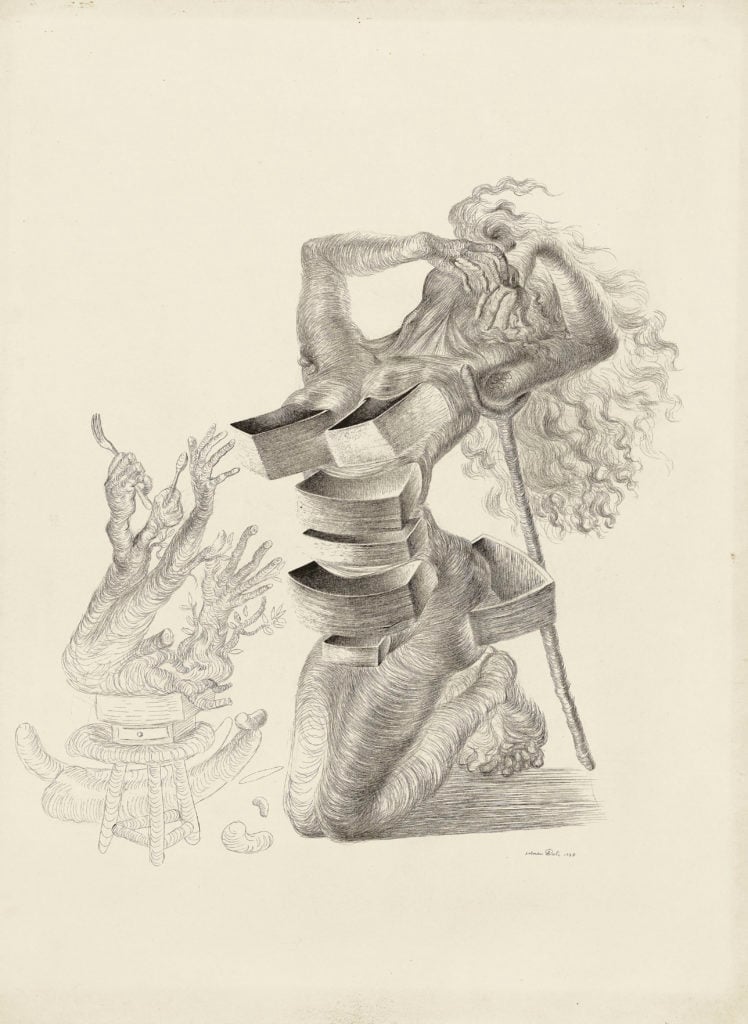
Salvador Dalí, Figure aux tiroirs (1937). Image courtesy of Christie’s Images Ltd.
In the post-sale press conference, Christie’s made reference to the success of its Modern British art sale, which the house scheduled on June 17-18 as part of its 20th-century week. Here, the top 10 lots were all sculptures, mostly by Barbara Hepworth and Henry Moore, who would qualify for inclusion in the Impressionist and Modern sales. Heading the list was a monumental figure from Hepworth’s bronze “Family of Man” series from 1970, which was underbid by US art advisor Abigail Asher before selling above estimate for £3.8 million ($4.8 million).
Another Hepworth, a shiny polished bronze, saw a protracted bidding battle before selling to Elaine Holt of Christie’s Hong Kong for a double-estimate £1.5 million ($1.9 million), while New York dealer Chris Eykyn beat off both Holt and Asher to claim Henry Moore’s large Working Model for Oval with Points, (1968-69) for a double-estimate £2 million ($2.5 million). Propping up the Barry Flanagan market was Stephane Custot, who underbid two typical hare bronzes that sold over estimate for £707,250 ($888,000) and £791,250 ($994,000).
Many of these sculptures benefited from extensive viewing outside of Christie’s in St. James’s Square in the weeks leading up to the sale. Bidders came from 16 different countries and four continents, according to Christie’s, which has been trying to position this essentially domestic market on the international stage.
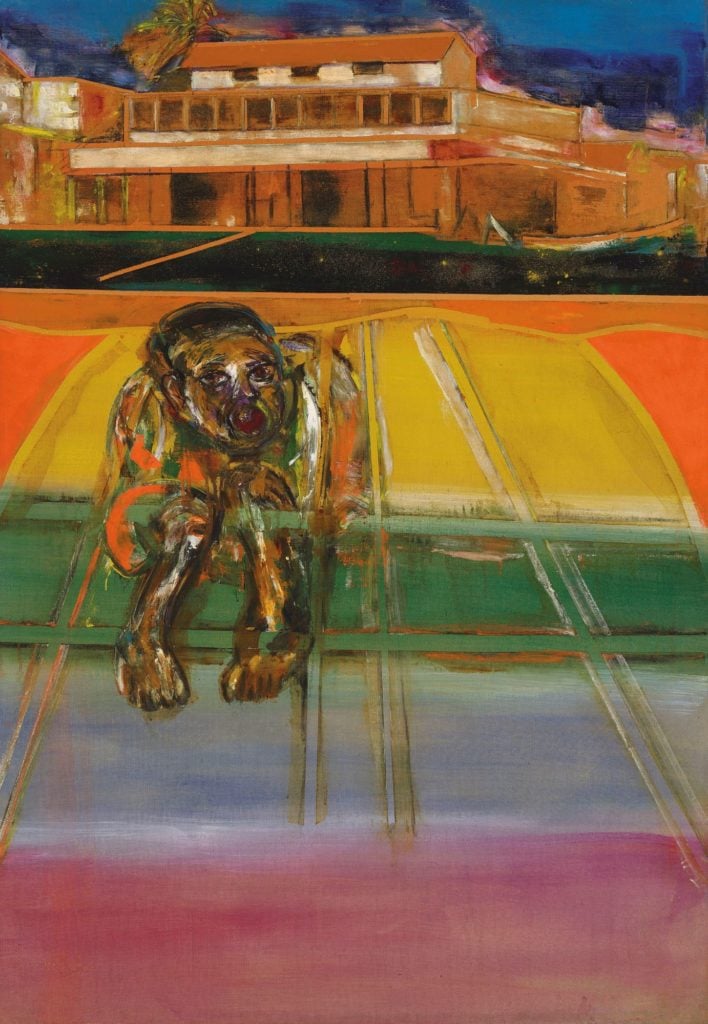
Frank Bowling, Beggar No. 3 (1963). Image courtesy of Christie’s Images Ltd.
The sale total of £17.5 million ($22 million) came comfortably within the £11.7 million to £17.5 million ($14.7-$22 million) estimate. It was then followed by a £5.8 million ($7.3 million) day sale, near the top estimate, in which the stand-out results were two successive records for the Caribbean-born, 85-year-old British artist Frank Bowling, whose work is currently touring in the groundbreaking “Soul of a Nation” exhibition and is the subject of a retrospective at Tate Britain. Bowling’s previous record was $161,000 for an abstract painting at a Swann’s New York African American art sale in 2017. Today in London, coming from the estate of painter David Methuen Campbell, a 1959 self-portrait, made while Bowling was still a student and estimated at £30,000-£50,000 ($38,000-$63,000) sold for £443,250 ($557,000).
A larger painting of a beggar outside Bowling’s mother’s house from 1963, when he displayed some influence from Francis Bacon, sold for £695,250 ($873,000) above an estimate of just £60,000 to £80,000 ($75,000-$100,000). Bowling’s bigger abstract paintings from the 1970s are now selling for more than $1 million privately, but this was the first evidence that the figurative work from his formative years could command such prices.